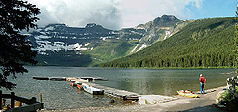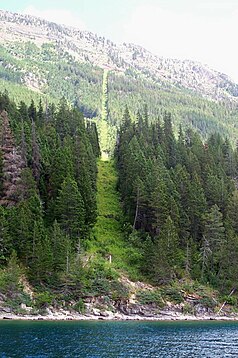Waterton Lakes National Park
| Waterton Lakes National Park | ||
|---|---|---|
| Lake Cameron in Waterton Lakes National Park | ||
|
|
||
| Location: | Alberta , Canada | |
| Next city: | Pincher Creek | |
| Surface: | 525 km² | |
| Founding: | 1895 | |
| Visitors: | 536,865 (2016/2017) | |
| Address: |
Waterton Lakes National Park Box 200 Waterton Park, AB Tel. (403) 859-2224 |
|
| The border between the USA and Canada in the park | ||
The Waterton Lakes National Park ( English Waterton Lakes National Park , French Parc national des Lacs-Waterton ) is located in the south of the Canadian province of Alberta directly on the border with the US state of Montana . It is approximately 270 km from Calgary and 560 km from Edmonton . The Waterton Lakes National Park was founded in 1895 as the fourth national park in Canada and got its name from three lakes ( Waterton Lakes : Upper - Middle - Lower). It has been a biosphere reserve since 1979 .
Location and natural conditions
With its rugged mountains, the park borders directly on the US Glacier National Park and together with it forms the Waterton-Glacier International Peace Park , which was declared a World Heritage Site by UNESCO in 1995 . The area of the park is 525 km², the highest point is Mount Blakiston at 2920 m . In the Waterton Lakes National Park, the eponymous chain of lakes is located at the transition between the endless prairies of the Great Plains and the Rocky Mountains , which rise from the plains without any promontory due to the Lewis Thrust .
Since it is a park that extends across borders, it is counted among the Peace Parks . The two national parks form the core of the Crown of the Continent Ecosystem , a natural area that extends far beyond the national parks in the Rocky Mountains.
To the west of the park is adjacent to the in British Columbia located Akamina-Kishinena Provincial Park , which is also still the Crown of the Continent Ecosystem belongs.
The park is open all year round, the main season is from July to August.
Wildlife
Although the national park is relatively small by Canadian standards, it is home to a diverse range of fauna: over 250 species of birds, 60 species of mammals, 24 species of fish and around ten species of reptiles and amphibians have been identified so far.
The diverse landscape offers a livelihood for all native predators ( wolf , puma , wolverine , grizzly bear and black bear ). On large ungulates are moose , elk -, mule and white-tailed deer , bison , bighorn sheep and mountain goat before.
Of the 255 recorded bird species, only 37 are year-round and 149 nest in the park. The lakes in the area are an important resting area for migratory bird species. Coots are often the first species to appear, followed by whistling swans , cinnamon , shoveler and cap saws .
Attractions
- Bear's Hump , a short hiking trail, 1.5 km long, approx. 200 meters in altitude, fantastic view of the Waterton Townsite from above, starts directly above the Visitor Center
- Boat tour on Upper Waterton Lake: Start from Waterton Townsite. The journey leads over the 49th parallel to the USA. Funny: the border with the USA can be seen with the naked eye; An aisle about 30 meters wide was cut in the forest on both sides of the lake. At the American end of the lake you can stretch your feet on a short march. Grandiose views of the mountains surrounding the lake.
- Red Rock Canyon
- Cameron Lake
Two structures in the park have been declared National Historic Site of Canada :
- The Prince-of-Wales Hotel , a rustic railway hotel of the Great Northern Railway , which was typical of hotel construction in Canadian national parks and
- First Oil Well in Western Canada , the first commercial oil well in Western Canada
Web links
- Waterton Lakes National Park , on Parks Canada , (Eng., Fr.)
- Waterton Lakes National Park ( English, French ) In: The Canadian Encyclopedia .
- Crypt Lake Trail
- Overview map, PDF
- Entry on the UNESCO World Heritage Center website ( English and French ).
Individual evidence
- ↑ UNESCO Biosphere Reserves. Waterton. In: Ecological Sciences for Sustainable Development. UNESCO , accessed April 11, 2013 .
- ↑ a b Comments on wildlife on the Parks Canada website, engl.
- ↑ Note on monuments in the national park on the homepage of Parks Canada, engl.



